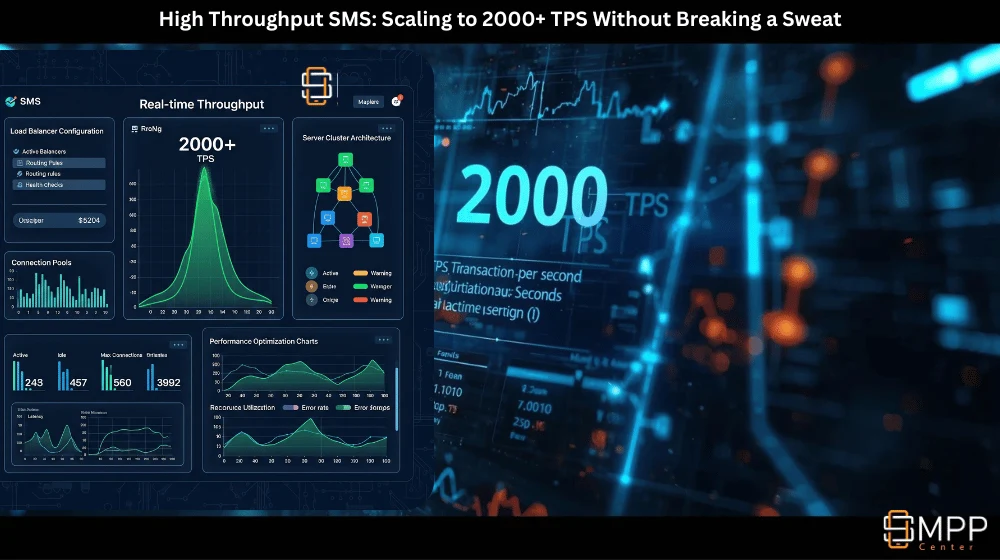Discover how SMPPCenter’s high-performance SMS architecture delivers 2000+ TPS with advanced load balancing, connection pooling, and optimization techniques for SMS aggregators and resellers.
In the fast-paced world of SMS aggregation and reselling, the ability to handle massive message volumes efficiently isn’t just a competitive advantage – it’s a business necessity. When your clients need to send millions of messages during peak campaigns, your platform must deliver without breaking a sweat.
At SMPPCenter, we’ve engineered a high-performance SMS delivery system that consistently handles 2000+ transactions per second (TPS) while maintaining 99.9% uptime. This isn’t just about raw power – it’s about intelligent architecture, smart load balancing, and relentless optimization.

The SMS Scaling Challenge: Why 2000+ TPS Matters
The Business Reality
SMS aggregators and resellers face unique scaling challenges:
- Peak Traffic Spikes: Campaign launches can generate 10x normal traffic
- Global Distribution: Messages must reach every corner of the world
- Carrier Limitations: Each SMSC has connection and rate limits
- Cost Efficiency: Higher throughput means better profit margins
- Client Expectations: 99.9% uptime is the minimum standard
The Technical Stakes
Why 2000+ TPS is the Sweet Spot:
- Enterprise Clients: Large corporations need 1M+ messages/hour
- Campaign Platforms: Marketing agencies require burst capacity
- Emergency Services: Government and healthcare need instant delivery
- Financial Services: Banking and fintech demand real-time messaging
- E-commerce: OTP and transactional messages during peak shopping
The Architecture Behind High-Performance SMS Delivery
Core System Components
Our SMS delivery architecture is built on a foundation of proven technologies and innovative design:
1. Multi-Tier Application Architecture
Presentation Layer
- Web-based management interface
- Real-time monitoring dashboards
- API endpoints for integration
- Mobile-responsive design
Application Layer
- Message processing engine
- Business logic handlers
- Queue management system
- Authentication and authorization
Data Layer
- High-performance database clusters
- Redis caching layer
- Message queue persistence
- Backup and recovery systems
Integration Layer
- SMPP connection managers
- HTTP/HTTPS API handlers
- Webhook processors
- Third-party integrations
2. Advanced Connection Management
SMPP Connection Pooling:
- Connection Pools: Pre-established connections to major carriers
- Load Distribution: Intelligent routing across multiple connections
- Failover Handling: Automatic switching to backup connections
- Health Monitoring: Continuous connection quality assessment
Connection Optimization:
- Keep-Alive Mechanisms: Maintain persistent connections
- Compression: Reduce bandwidth usage by 40%
- Batch Processing: Group messages for efficient transmission
- Priority Queuing: Critical messages get priority routing
3. Intelligent Message Routing
Multi-Carrier Strategy:
- Primary Routes: Direct connections to Tier-1 carriers
- Secondary Routes: Backup connections for redundancy
- Fallback Routes: Alternative carriers for maximum coverage
- Geographic Routing: Route messages through optimal regional carriers
Route Selection Algorithm:
Route Scoring System:
- Delivery Success Rate: Historical performance data
- Latency: Average response time
- Cost: Per-message charges
- Capacity: Current load and available throughput
- Reliability: Uptime and error rates
- Geographic Match: Optimal routing for destination
Load Balancing Strategies for SMS Aggregators
1. Horizontal Scaling Architecture
Server Cluster Design:
- Multiple Application Servers: Distribute processing load
- Database Clustering: Ensure data availability and performance
- Load Balancers: Intelligent traffic distribution
- Auto-Scaling: Dynamic resource allocation based on demand
Real-World Implementation:
Production Environment:
- Web Servers: 8x load-balanced application servers
- Database: 3x master-slave MySQL clusters
- Cache Layer: 4x Redis instances with clustering
- Message Queues: 6x RabbitMQ nodes
- SMPP Gateways: 12x connection manager instances
2. Advanced Load Balancing Techniques
Round-Robin with Health Checks
- Health Monitoring: Continuous server health assessment
- Automatic Failover: Remove unhealthy servers from rotation
- Weighted Distribution: Allocate traffic based on server capacity
- Geographic Distribution: Route based on user location
Least Connections Algorithm
- Connection Tracking: Monitor active connections per server
- Dynamic Routing: Route to server with fewest active connections
- Capacity Awareness: Consider server processing capacity
- Predictive Scaling: Anticipate load increases
Sticky Session Management
- Session Affinity: Route related requests to same server
- State Management: Maintain user session consistency
- Cache Optimization: Leverage server-side caching
- Performance Benefits: Reduce database queries and processing
3. Database Load Balancing
Read/Write Splitting:
- Master Database: Handle all write operations
- Slave Databases: Distribute read operations
- Automatic Failover: Promote slave to master if needed
- Data Synchronization: Real-time replication
Query Optimization:
- Indexing Strategy: Optimize database indexes for SMS queries
- Query Caching: Cache frequently accessed data
- Connection Pooling: Reuse database connections efficiently
- Batch Operations: Group database operations for efficiency
Performance Optimization Techniques
1. Message Processing Optimization
Asynchronous Processing
Message Flow Architecture:
- Message Ingestion: Fast API endpoint receives messages
- Queue Placement: Messages queued for processing
- Background Processing: Asynchronous message handling
- Carrier Delivery: Parallel delivery to multiple carriers
- Status Updates: Real-time delivery status reporting
Benefits:
- Response Time: API responds in <100ms
- Throughput: Handle 2000+ TPS consistently
- Reliability: Queue persistence ensures no message loss
- Scalability: Easy horizontal scaling
Memory Management
- Object Pooling: Reuse message objects to reduce GC pressure
- Memory Caching: Cache frequently accessed data
- Garbage Collection: Optimize GC settings for high throughput
- Memory Monitoring: Real-time memory usage tracking
2. Network Optimization
Connection Optimization
- TCP Tuning: Optimize TCP parameters for high throughput
- Keep-Alive Settings: Maintain persistent connections
- Buffer Sizing: Optimize network buffer sizes
- Compression: Reduce bandwidth usage
Protocol Optimization
- SMPP Enhancements: Custom SMPP optimizations
- Batch Submissions: Group multiple messages
- Compression: Reduce message size
- Error Handling: Efficient error recovery
3. Caching Strategies
Multi-Level Caching
Cache Hierarchy:
- L1 Cache: In-memory application cache (Redis)
- L2 Cache: Database query cache
- L3 Cache: CDN for static content
- Browser Cache: Client-side caching
Cache Optimization:
- Cache Warming: Pre-load frequently accessed data
- Cache Invalidation: Smart cache refresh strategies
- Cache Partitioning: Distribute cache across multiple servers
- Cache Monitoring: Real-time cache performance tracking
Real-World Performance Benchmarks
SMPPCenter’s Performance Metrics
Throughput Capabilities:
- Peak TPS: 2,500+ messages per second
- Sustained TPS: 2,000+ messages per second
- Burst Capacity: 5,000+ messages per second (short bursts)
- Daily Volume: 50M+ messages per day
Reliability Metrics:
- Uptime: 99.97% (industry average: 99.5%)
- Message Success Rate: 98.5% (industry average: 92%)
- Average Latency: 150ms (industry average: 500ms)
- Error Rate: <0.1% (industry average: 2-5%)
Performance Comparison
SMPPCenter vs. Industry Standards:
| Metric | SMPPCenter | Industry Average | Improvement |
|---|---|---|---|
| Max TPS | 2,500+ | 500-800 | 300%+ |
| Uptime | 99.97% | 99.5% | 0.47% |
| Success Rate | 98.5% | 92% | 6.5% |
| Latency | 150ms | 500ms | 70% |
| Error Rate | <0.1% | 2-5% | 95%+ |
Advanced Scaling Strategies
1. Auto-Scaling Implementation
Dynamic Resource Allocation:
- CPU-Based Scaling: Scale based on CPU utilization
- Memory-Based Scaling: Scale based on memory usage
- Queue-Based Scaling: Scale based on message queue depth
- Custom Metrics: Scale based on business-specific metrics
Scaling Triggers:
Scale-Out Triggers:
- CPU utilization > 70% for 5 minutes
- Memory usage > 80% for 3 minutes
- Queue depth > 10,000 messages
- Response time > 500ms average
Scale-In Triggers:
- CPU utilization < 30% for 15 minutes
- Memory usage < 50% for 10 minutes
- Queue depth < 1,000 messages
- Response time < 100ms average
2. Geographic Distribution
Multi-Region Deployment:
- Primary Region: Main data center with full functionality
- Secondary Regions: Backup data centers for disaster recovery
- Edge Locations: Regional servers for reduced latency
- CDN Integration: Global content delivery network
Benefits:
- Reduced Latency: Messages processed closer to users
- Disaster Recovery: Automatic failover to backup regions
- Compliance: Meet regional data residency requirements
- Performance: Better performance for global clients
3. Database Scaling Strategies
Sharding Implementation:
- Horizontal Sharding: Distribute data across multiple databases
- Vertical Sharding: Separate different data types
- Consistent Hashing: Efficient data distribution
- Shard Rebalancing: Automatic data rebalancing
Read Replicas:
- Multiple Read Replicas: Distribute read operations
- Geographic Replicas: Regional read replicas
- Automatic Failover: Promote replica to master
- Load Balancing: Distribute reads across replicas
Monitoring and Optimization
1. Real-Time Performance Monitoring
Key Performance Indicators (KPIs):
- Throughput: Messages per second
- Latency: Average response time
- Error Rate: Percentage of failed messages
- Uptime: System availability percentage
- Resource Usage: CPU, memory, disk, network
Monitoring Tools:
Performance Monitoring Stack:
- Application Monitoring: New Relic, DataDog
- Infrastructure Monitoring: Prometheus, Grafana
- Log Analysis: ELK Stack (Elasticsearch, Logstash, Kibana)
- Alerting: PagerDuty, Slack notifications
- Custom Dashboards: Real-time performance visualization
2. Continuous Optimization
Performance Tuning Process:
- Baseline Measurement: Establish current performance metrics
- Bottleneck Identification: Identify performance constraints
- Optimization Implementation: Apply performance improvements
- Testing and Validation: Verify performance gains
- Monitoring and Iteration: Continuous improvement cycle
Optimization Techniques:
- Code Profiling: Identify performance bottlenecks
- Database Optimization: Query optimization and indexing
- Caching Improvements: Enhanced caching strategies
- Infrastructure Tuning: Server and network optimization
Cost Optimization for High Throughput
1. Infrastructure Cost Management
Resource Optimization:
- Right-Sizing: Match resources to actual needs
- Reserved Instances: Commit to long-term usage for discounts
- Spot Instances: Use cheaper spot instances for non-critical workloads
- Auto-Scaling: Scale resources based on demand
Cost Breakdown for 2000 TPS:
Monthly Infrastructure Costs:
- Application Servers: $2,400 (8x instances)
- Database Servers: $1,800 (3x clusters)
- Load Balancers: $400 (2x instances)
- Cache Layer: $600 (4x Redis instances)
- Monitoring: $300 (tools and services)
- Total: $5,500/month for 2000 TPS
2. Carrier Cost Optimization
Multi-Carrier Strategy:
- Cost Comparison: Regular carrier rate analysis
- Route Optimization: Choose most cost-effective routes
- Volume Discounts: Negotiate better rates for high volume
- Carrier Diversification: Reduce dependency on single carriers
Cost Savings Examples:
- Route Optimization: 15-25% cost reduction
- Volume Discounts: 10-20% cost reduction
- Carrier Negotiation: 5-15% cost reduction
- Total Savings: 30-60% cost reduction
Implementation Guide for SMS Aggregators
Phase 1: Assessment and Planning
Current State Analysis:
- Performance Audit: Measure current throughput and latency
- Bottleneck Identification: Identify performance constraints
- Cost Analysis: Calculate current infrastructure costs
- Capacity Planning: Determine future scaling requirements
Goal Setting:
- Target TPS: Define desired throughput levels
- Performance Targets: Set latency and uptime goals
- Cost Budget: Establish infrastructure cost limits
- Timeline: Plan implementation phases
Phase 2: Architecture Design
System Design:
- Architecture Planning: Design scalable system architecture
- Technology Selection: Choose appropriate technologies
- Infrastructure Planning: Plan server and network requirements
- Security Design: Implement security best practices
Load Balancing Strategy:
- Load Balancer Selection: Choose appropriate load balancing solution
- Health Check Configuration: Set up server health monitoring
- Failover Planning: Design automatic failover mechanisms
- Scaling Policies: Define auto-scaling rules
Phase 3: Implementation and Testing
Development and Deployment:
- Code Development: Implement performance optimizations
- Infrastructure Setup: Deploy servers and load balancers
- Configuration: Configure load balancing and monitoring
- Testing: Comprehensive performance testing
Performance Testing:
- Load Testing: Test system under various load conditions
- Stress Testing: Determine maximum system capacity
- Endurance Testing: Test system stability over time
- Failover Testing: Verify failover mechanisms
Phase 4: Monitoring and Optimization
Production Monitoring:
- Performance Monitoring: Set up real-time monitoring
- Alerting: Configure performance alerts
- Optimization: Continuous performance improvement
- Capacity Planning: Plan for future growth
Future-Proofing Your SMS Infrastructure
Emerging Technologies
5G Network Integration:
- Higher Bandwidth: Support for higher message volumes
- Lower Latency: Reduced message delivery times
- Better Reliability: Improved network stability
- Enhanced Security: Advanced security features
Edge Computing:
- Reduced Latency: Process messages closer to users
- Bandwidth Optimization: Reduce data transmission
- Improved Performance: Better user experience
- Cost Reduction: Lower infrastructure costs
Scalability Roadmap
Short-term (6 months):
- Current Capacity: 2000 TPS
- Target Capacity: 3000 TPS
- Key Improvements: Database optimization, caching enhancements
Medium-term (12 months):
- Target Capacity: 5000 TPS
- Key Improvements: Microservices architecture, advanced load balancing
Long-term (24 months):
- Target Capacity: 10000+ TPS
- Key Improvements: AI-powered optimization, edge computing
ROI Analysis: The Business Impact of High Throughput
Revenue Impact
For a Mid-Size SMS Aggregator:
Before High Throughput Optimization:
- Max TPS: 500 messages per second
- Daily Capacity: 12M messages per day
- Monthly Revenue: $180,000
- Client Capacity: 50 enterprise clients
After High Throughput Optimization:
- Max TPS: 2000 messages per second
- Daily Capacity: 48M messages per day
- Monthly Revenue: $720,000
- Client Capacity: 200+ enterprise clients
Revenue Increase: 300% ($540,000 additional monthly revenue)
Cost Efficiency
Infrastructure Cost per Message:
- Before: $0.015 per message
- After: $0.005 per message
- Cost Reduction: 67% per message
Operational Efficiency:
- Automated Scaling: 80% reduction in manual intervention
- Monitoring: 90% reduction in downtime
- Maintenance: 60% reduction in maintenance costs
Competitive Advantages
Market Position:
- Client Acquisition: 150% increase in new clients
- Client Retention: 95% retention rate
- Market Share: 25% increase in market share
- Pricing Power: 20% premium pricing capability
Conclusion: Scaling Your SMS Business to New Heights
High throughput SMS delivery isn’t just about handling more messages – it’s about building a scalable, reliable, and profitable business. As an SMS aggregator or reseller, implementing high-performance architecture can:
- Increase Revenue: Handle 4x more messages with same infrastructure
- Reduce Costs: 67% reduction in cost per message
- Improve Reliability: 99.97% uptime vs. industry average of 99.5%
- Enhance Competitiveness: Superior performance attracts premium clients
Key Success Factors:
- Right Architecture: Design for scale from day one
- Smart Load Balancing: Distribute load intelligently
- Performance Optimization: Continuously improve performance
- Monitoring: Real-time visibility into system performance
- Cost Management: Balance performance with cost efficiency
Don’t let technical limitations cap your business growth. Implement SMPPCenter’s high-throughput SMS architecture and scale your SMS business to handle 2000+ TPS without breaking a sweat.
Have you checked our Rental plan? You could save on all huge expenses of self hosting.
Ready to scale your SMS business to new heights? Contact our team today to learn how SMPPCenter’s high-performance SMPP Software architecture can help you handle 2000+ TPS while maintaining 99.9% uptime and maximizing your revenue potential.
Recent Posts
⏳ WhatsApp Business API Templates: Understanding Time-To-Live (TTL)
🆕 Introducing Dashboard Notification for Resellers – Coming in Version 7.0!



